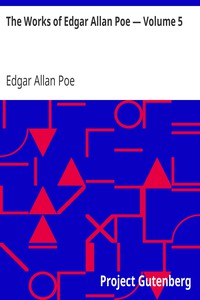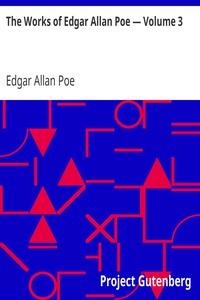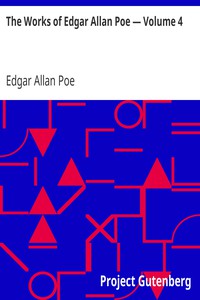The Works of Edgar Allan Poe — Volume 1 by Edgar Allan Poe (white hot kiss .txt) 📖

- Author: Edgar Allan Poe
Book online «The Works of Edgar Allan Poe — Volume 1 by Edgar Allan Poe (white hot kiss .txt) 📖». Author Edgar Allan Poe
(*17) New York “Express”
(*18) New York “Herald.”
(*19) New York “Courier and Inquirer.”
(*20) Mennais was one of the parties originally suspected and arrested, but discharged through total lack of evidence.
(*21) New York “Courier and Inquirer.”
(*22) New York “Evening Post.”
(*23) Of the Magazine in which the article was originally published.
[Astounding News by Express, via Norfolk!—The Atlantic crossed in Three Days! Signal Triumph of Mr. Monck Mason’s Flying Machine!—Arrival at Sullivan’s Island, near Charlestown, S.C., of Mr. Mason, Mr. Robert Holland, Mr. Henson, Mr. Harrison Ainsworth, and four others, in the Steering Balloon, “Victoria,” after a passage of Seventy-five Hours from Land to Land! Full Particulars of the Voyage!
The subjoined jeu d’esprit with the preceding heading in magnificent capitals, well interspersed with notes of admiration, was originally published, as matter of fact, in the “New York Sun,” a daily newspaper, and therein fully subserved the purpose of creating indigestible aliment for the quidnuncs during the few hours intervening between a couple of the Charleston mails. The rush for the “sole paper which had the news,” was something beyond even the prodigious; and, in fact, if (as some assert) the “Victoria” did not absolutely accomplish the voyage recorded, it will be difficult to assign a reason why she should not have accomplished it.]
The great problem is at length solved! The air, as well as the earth and the ocean, has been subdued by science, and will become a common and convenient highway for mankind. The Atlantic has been actually crossed in a Balloon! and this too without difficulty—without any great apparent danger—with thorough control of the machine—and in the inconceivably brief period of seventy-five hours from shore to shore! By the energy of an agent at Charleston, S.C., we are enabled to be the first to furnish the public with a detailed account of this most extraordinary voyage, which was performed between Saturday, the 6th instant, at 11, A.M., and 2, P.M., on Tuesday, the 9th instant, by Sir Everard Bringhurst; Mr. Osborne, a nephew of Lord Bentinck’s; Mr. Monck Mason and Mr. Robert Holland, the well-known æronauts; Mr. Harrison Ainsworth, author of “Jack Sheppard,” &c.; and Mr. Henson, the projector of the late unsuccessful flying machine—with two seamen from Woolwich—in all, eight persons. The particulars furnished below may be relied on as authentic and accurate in every respect, as, with a slight exception, they are copied verbatim from the joint diaries of Mr. Monck Mason and Mr. Harrison Ainsworth, to whose politeness our agent is also indebted for much verbal information respecting the balloon itself, its construction, and other matters of interest. The only alteration in the MS. received, has been made for the purpose of throwing the hurried account of our agent, Mr. Forsyth, into a connected and intelligible form.
“THE BALLOON.
“Two very decided failures, of late—those of Mr. Henson and Sir George Cayley—had much weakened the public interest in the subject of aerial navigation. Mr. Henson’s scheme (which at first was considered very feasible even by men of science,) was founded upon the principle of an inclined plane, started from an eminence by an extrinsic force, applied and continued by the revolution of impinging vanes, in form and number resembling the vanes of a windmill. But, in all the experiments made with models at the Adelaide Gallery, it was found that the operation of these fans not only did not propel the machine, but actually impeded its flight. The only propelling force it ever exhibited, was the mere impetus acquired from the descent of the inclined plane; and this impetus carried the machine farther when the vanes were at rest, than when they were in motion—a fact which sufficiently demonstrates their inutility; and in the absence of the propelling, which was also the sustaining power, the whole fabric would necessarily descend. This consideration led Sir George Cayley to think only of adapting a propeller to some machine having of itself an independent power of support—in a word, to a balloon; the idea, however, being novel, or original, with Sir George, only so far as regards the mode of its application to practice. He exhibited a model of his invention at the Polytechnic Institution. The propelling principle, or power, was here, also, applied to interrupted surfaces, or vanes, put in revolution. These vanes were four in number, but were found entirely ineffectual in moving the balloon, or in aiding its ascending power. The whole project was thus a complete failure.
“It was at this juncture that Mr. Monck Mason (whose voyage from Dover to Weilburg in the balloon, “Nassau,” occasioned so much excitement in 1837,) conceived the idea of employing the principle of the Archimedean screw for the purpose of propulsion through the air—rightly attributing the failure of Mr. Henson’s scheme, and of Sir George Cayley’s, to the interruption of surface in the independent vanes. He made the first public experiment at Willis’s Rooms, but afterward removed his model to the Adelaide Gallery.
“Like Sir George Cayley’s balloon, his own was an ellipsoid. Its length was thirteen feet six inches—height, six feet eight inches. It contained about three hundred and twenty cubic feet of gas, which, if pure hydrogen, would support twenty-one pounds upon its first inflation, before the gas has time to deteriorate or escape. The weight of the whole machine and apparatus was seventeen pounds—leaving about four pounds to spare. Beneath the centre of the balloon, was a frame of light wood, about nine feet long, and rigged on to the balloon itself with a network in the customary manner. From this framework was suspended a wicker basket or car.
“The screw consists of an axis of hollow brass tube, eighteen inches in length, through which, upon a semi-spiral inclined at fifteen degrees, pass a series of steel wire radii, two feet long, and thus projecting a foot on either side. These radii are connected at the outer extremities by two bands of flattened wire—the whole in this manner forming the framework of the screw, which is completed by a covering of oiled silk cut into gores, and tightened so as to present a tolerably uniform surface. At each end of its axis this screw is supported by pillars of hollow brass tube descending from the hoop. In the lower ends of these tubes are holes in which the pivots of the axis revolve. From the end of the axis which is next the car, proceeds a shaft of steel, connecting the screw with the pinion of a piece of spring machinery fixed in the car. By the operation of this spring, the screw is made to revolve with great rapidity, communicating a progressive motion to the whole. By means of the rudder, the machine was readily turned in any direction. The spring was of great power, compared with its dimensions, being capable of raising forty-five pounds upon a barrel of four inches diameter, after the first turn, and gradually increasing as it was wound up. It weighed, altogether, eight pounds six ounces. The rudder was a light frame of cane covered with silk, shaped somewhat like a battle-door, and was about three feet long, and at the widest, one foot. Its weight was about two ounces. It could be turned flat, and directed upwards or downwards, as well as to the right or left; and thus enabled the æronaut to transfer the resistance of the air which in an inclined position it must generate in its passage, to any side upon which he might desire to act; thus determining the balloon in the opposite direction.
“This model (which, through want of time, we have necessarily described in an imperfect manner,) was put in action at the Adelaide Gallery, where it accomplished a velocity of five miles per hour; although, strange to say, it excited very little interest in comparison with the previous complex machine of Mr. Henson—so resolute is the world to despise anything which carries with it an air of simplicity. To accomplish the great desideratum of ærial navigation, it was very generally supposed that some exceedingly complicated application
 Have you ever thought about what fiction is? Probably, such a question may seem surprising: and so everything is clear. Every person throughout his life has to repeatedly create the works he needs for specific purposes - statements, autobiographies, dictations - using not gypsum or clay, not musical notes, not paints, but just a word. At the same time, almost every person will be very surprised if he is told that he thereby created a work of fiction, which is very different from visual art, music and sculpture making. However, everyone understands that a student's essay or dictation is fundamentally different from novels, short stories, news that are created by professional writers. In the works of professionals there is the most important difference - excogitation. But, oddly enough, in a school literature course, you don’t realize the full power of fiction. So using our website in your free time discover fiction for yourself.
Have you ever thought about what fiction is? Probably, such a question may seem surprising: and so everything is clear. Every person throughout his life has to repeatedly create the works he needs for specific purposes - statements, autobiographies, dictations - using not gypsum or clay, not musical notes, not paints, but just a word. At the same time, almost every person will be very surprised if he is told that he thereby created a work of fiction, which is very different from visual art, music and sculpture making. However, everyone understands that a student's essay or dictation is fundamentally different from novels, short stories, news that are created by professional writers. In the works of professionals there is the most important difference - excogitation. But, oddly enough, in a school literature course, you don’t realize the full power of fiction. So using our website in your free time discover fiction for yourself. 




Comments (0)